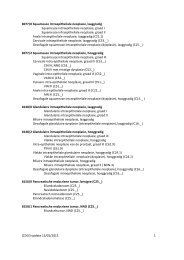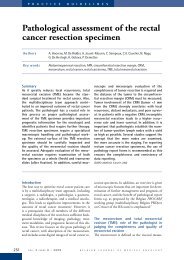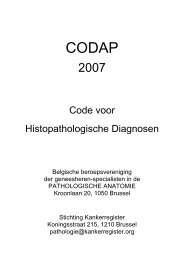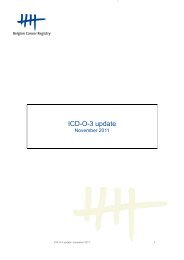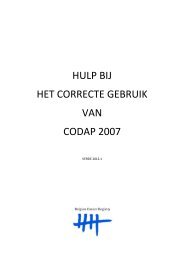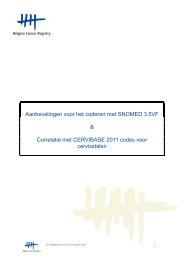Assurance de qualité pour le cancer rectal – phase 2 ...
Assurance de qualité pour le cancer rectal – phase 2 ...
Assurance de qualité pour le cancer rectal – phase 2 ...
You also want an ePaper? Increase the reach of your titles
YUMPU automatically turns print PDFs into web optimized ePapers that Google loves.
KCE Reports 81 PROCARE <strong>–</strong> <strong>phase</strong> 2 49Using the administrative database, this QI is measurab<strong>le</strong> for 124 centres. Thirty-twocentres have a score of 0%, whi<strong>le</strong> in 14 centres the inpatient or 30-day mortalityexceeds 10%. Sixty-three centres have a score above the weighted (5%; 95%CI 4 <strong>–</strong> 6%)and unweighted mean (5%; 95%CI 4 <strong>–</strong> 6%).Importantly, extensive risk-adjustment (e.g. age, stage, comorbidities) is necessary forthe correct interpretation of these results.Tab<strong>le</strong> 37. Inpatient or 30-day mortality, measured with prospectivePROCARE data.NPatients with <strong>rectal</strong> <strong>cancer</strong> 1071Patients with social security number and Belgian postal co<strong>de</strong>, and un<strong>de</strong>rwent surgery 1064Patients with surgery before December 2 nd 2006 (<strong>de</strong>nominator) 693Patients that died in hospital or within 30 days after surgery (numerator) 20 (3%)Rate of intra-operative <strong>rectal</strong> perforationDEFINITIONNumerator: all patients with RC that un<strong>de</strong>rwent radical resection and had intra-operative<strong>rectal</strong> perforation.Denominator: all patients with RC that un<strong>de</strong>rwent radical resection.Exclusion:• patients not un<strong>de</strong>rgoing radical resectionRESULTSSeven percent of the PROCARE patients un<strong>de</strong>rgoing radical resection had a <strong>rectal</strong>perforation during surgery (Tab<strong>le</strong> 38). It was not possib<strong>le</strong> to i<strong>de</strong>ntify missing data, sincethe <strong>de</strong>fault value of the variab<strong>le</strong> was ‘0’ (see appendix).Intra-operative <strong>rectal</strong> perforation is measurab<strong>le</strong> for 56 centres using the prospectivedatabase. Twenty-five centres have a score of 0%, whi<strong>le</strong> 17 centres have a score of 10%or more. Thirty-five centres have a score above the weighted (7%; 95%CI 5 <strong>–</strong> 8%) andunweighted mean (6%; 95%CI 4 <strong>–</strong> 8%). Risk-adjustment (tumour localisation [includingdorsal <strong>–</strong> ventral], stage) is necessary for the correct interpretation of these results.The QI is not measurab<strong>le</strong> for the administrative cohort, since no specific co<strong>de</strong> exists forintra-operative <strong>rectal</strong> perforation.Tab<strong>le</strong> 38. Number of intra-operative <strong>rectal</strong> perforations, measured withprospective PROCARE data.NPatients with <strong>rectal</strong> <strong>cancer</strong> 1071Patients having radical resection (<strong>de</strong>nominator) 1018Patients with intra-operative <strong>rectal</strong> perforation (numerator) 69 (7%)DiscussionUsing the prospective database, 5 of the 6 surgical QI are measurab<strong>le</strong> (Tab<strong>le</strong> 39). Therate of stoma at 1 year after SSO is not measurab<strong>le</strong> at present, but can be ren<strong>de</strong>redmeasurab<strong>le</strong> by asking specifically for the presence of a stoma at 1 year. Another solutionis to link the prospective database to the administrative databases, where this QI isalready measurab<strong>le</strong>. However, in that case, i<strong>le</strong>o/colostomies should be distinguishedfrom urostomies, e.g. by excluding patients un<strong>de</strong>rgoing a Bricker’s procedure.Three QI are not measurab<strong>le</strong> using the administrative databases due to the absence ofadministrative co<strong>de</strong>s (for R0 resection, major <strong>le</strong>akage of the anastomosis and intraoperativeperforation). All three QI are measurab<strong>le</strong> using the prospective database.As already stated, in the number of R0 resections the results of the pathology reportare not taken into account at present. I<strong>de</strong>ally, the real R0 should be used in the future,i.e. taking into account the pathology results and intra-operative perforation.



